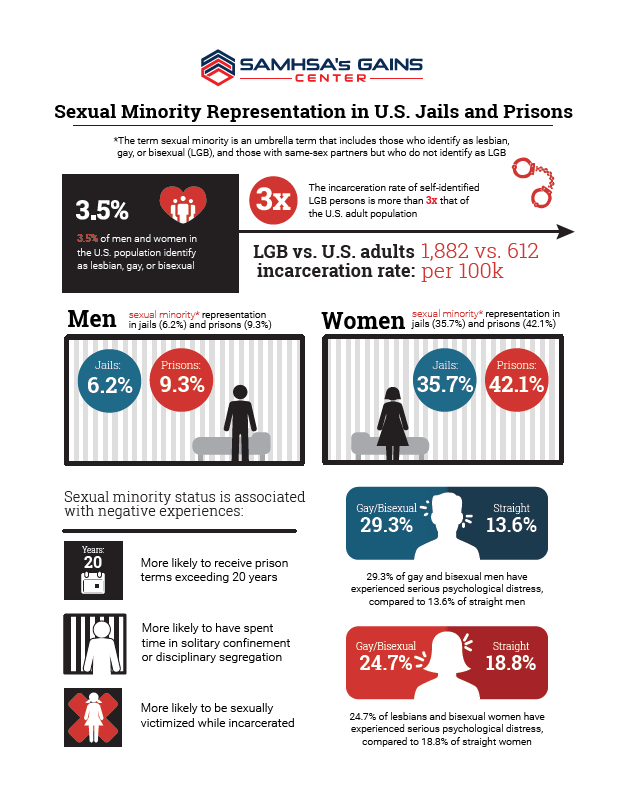 By Ilan H. Meyer, Ph.D., Williams Distinguished Senior Scholar for Public Policy, Williams Institute, University of California, Los Angeles (UCLA) School of Law; Adjunct Professor, Community Health Sciences, UCLA Fielding School of Public Health; and Professor Emeritus of Sociomedical Sciences, Columbia University Mailman School of Public Health
By Ilan H. Meyer, Ph.D., Williams Distinguished Senior Scholar for Public Policy, Williams Institute, University of California, Los Angeles (UCLA) School of Law; Adjunct Professor, Community Health Sciences, UCLA Fielding School of Public Health; and Professor Emeritus of Sociomedical Sciences, Columbia University Mailman School of Public Health
In a 2017 analysis of data from the National Inmate Survey—a nationally representative survey of adult inmates in jails and prisons conducted by the U.S. Department of Justice, Bureau of Justice Statistics—a research team from the Williams Institute at the UCLA School of Law found that of men in jails, 6.2 percent were sexual minorities. This percentage includes 3.3 percent gay or bisexual men and 2.9 percent who reported having had sex with men before arrival at the facility but did not self-identify as gay or bisexual (men who have sex with men, or MSM). Among men in prisons, 9.3 percent were sexual minorities, including 5.5 percent gay or bisexual men and 3.8 percent identifying as MSM. Among women in jails, 35.7 percent were sexual minorities, including 26.4 percent lesbian or bisexual women and 9.3 percent who reported sex with women before arrival at the facility but did not identify as lesbian or bisexual (women who have sex with women, or WSW). Among women in prison, 42.1 percent were sexual minorities. This percentage includes 33.3 percent (standard error of 0.6) lesbian or bisexual women and 8.8 percent identifying as WSW.[i],[ii] By comparison, it is estimated that about 3.5 percent of men and of women in the United States identify as lesbian, gay, or bisexual (LGB). This demonstrates an overrepresentation of LGB people in jails and prisons, with a more than 10-fold representation of lesbian and bisexual women in prisons.[iii] The incarceration rate of self-identified lesbian, gay, or bisexual persons was 1,882 per 100,000, more than 3 times that of the U.S. adult population (662 per 100,000).[iv]
The Williams Institute’s research team also found that LGB individuals receive longer sentences than heterosexual individuals, with lesbian or bisexual women and gay or bisexual men 4.6 and 2.7 times more likely than heterosexual women and men to receive prison terms exceeding 20 years, respectively. Additionally, sexual minorities were more likely to have spent time in disciplinary or administrative segregation or solitary confinement while incarcerated—26.8 percent of gay and bisexual men as compared with 18.2 percent of straight men and 37.2 percent of lesbians and bisexual women as compared with 12.7 percent of straight women experienced solitary confinement while incarcerated. And compared with straight inmates, sexual minorities are more likely to be sexually victimized while incarcerated—17.5 percent of gay and bisexual men and 13.1 percent of lesbians and bisexual women have been sexually assaulted by another inmate or staff as compared with 2.6 percent and 5.7 percent of straight men and women, respectively.
Separately, the study found that a high proportion of LGB individuals have experienced serious psychological distress, with 29.3 percent of gay and bisexual men compared with 13.6 percent of straight men and 24.7 percent of lesbians and bisexual women compared with 18.8 percent of straight women experiencing poor mental health.
This analysis cannot explain why sexual minorities are incarcerated at higher rates than the general U.S. population or why they have different experiences once incarcerated. However, based on the data, criminal justice professionals and behavioral health providers should consider sexual minority status as one indicator of potential risk for negative incarceration outcomes, sexual assault, and poor mental health. Further studies ought to assess how pathways to incarceration differ between sexual minorities and heterosexuals, including how societal prejudice and stigma may affect disparities in arrest, sentencing, and incarceration experiences.
Click here for a text alternative to the graphic that accompanies this story.
[i] We use the term sexual minorities to include LGB people and people who have had same-sex partners prior to incarceration but do not identify as LGB.
[ii] Meyer, I. H., Flores, A. R., Stemple, L., Romero, A. P., Wilson, B. D. M., Herman, J. L. (2017). Incarceration Rates and Traits of Sexual Minorities in the United States: National Inmate Survey, 2011-2012. American Journal of Public Health 107(2): 267-273. doi: https://doi.org/10.2105/AJPH.2016.303576
[iii] Gates, G. J. (2011). How many people are lesbian, gay, bisexual, and transgender? Retrieved from the Williams Institute at UCLA School of Law website: https://williamsinstitute.law.ucla.edu/wp-content/uploads/Gates-How-Many-People-LGBT-Apr-2011.pdf
[iv] Bureau of Justice Statistics. (2015, September 17). U.S. prison population declined one percent in 2014. Retrieved from http://www.bjs.gov/content/pub/press/p14pr.cfm
Like what you’ve read? Sign up for the GAINS listserv!


